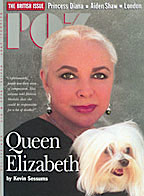 |
On World AIDS Day, model-turned-spokesperson Kathy Ireland told Entertainment Tonight that her friend the late Elizabeth Taylor turned her Bel Air mansion into “a safe house,” where illegal AIDS meds were smuggled in, and that “and a lot of the work that she did, it was illegal, but she was saving lives.”
This was news to AIDS activists, particularly those in California who did set up buyers clubs for unapproved AIDS meds. So is Ireland’s story true?
Writing in New York magazine, former POZ editor-in-chief Walter Armstrong tries to get to the facts. Turns out, most everyone quoted in the article—including people who worked with Taylor during the 1980s and 1990s—thinks the story is untrue. At least how it was described by the reporter: as being like a “West Coast Buyers Club,” a reference to the Oscar-winning film Dallas Buyers Club.
POZ founder Sean Strub said, “The report that Elizabeth Taylor ‘ran an underground network’ importing drugs is news to me, and I was involved in several of those networks. She might have contributed financially to help pay for travel expenses for the couriers or to buy ingredients or drugs, but if she did it was a well-kept secret.
“As for the ‘safe house’ for people with AIDS, I don’t know what that even could mean. She was very generous and compassionate, and she may have had some patients stay with her, but I never heard of her doing so.”
Strub noted that in 1997 Taylor became the first HIV-negative person to be shot for the cover of POZ magazine.
Why does it matter if Taylor created a so-called “safe house”? As Strub explained: “Making up stories to embellish Taylor’s important AIDS activist legacy dishonors it and is an insult to the people with AIDS and our allies who did put themselves at risk to access experimental treatments in those days. It is important that we are vigilant in making sure that history is recorded accurately.”






1 Comment
1 Comment